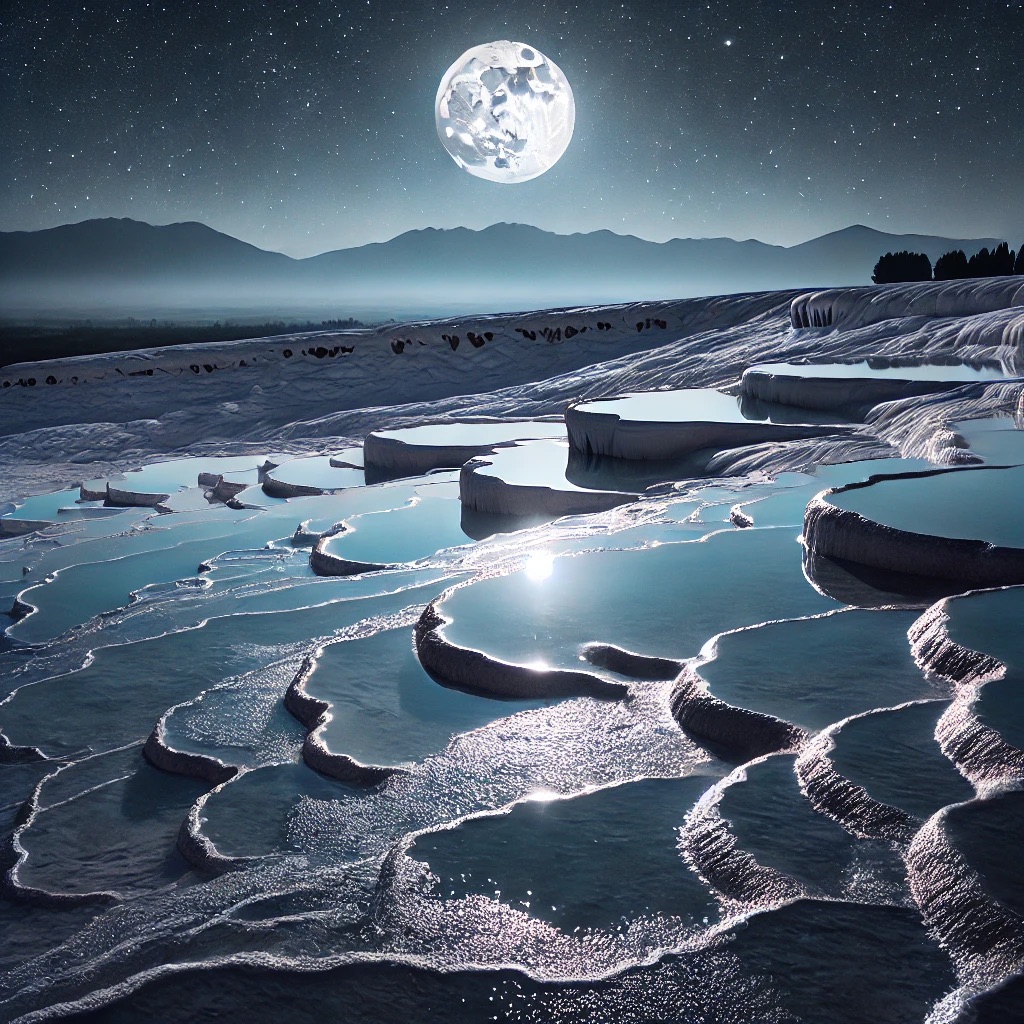ChatGPT:Pamukkale, located in southwestern Turkey, is renowned for its stunning white travertine terraces formed by mineral-rich thermal waters. Pamukkale, which means “Cotton Castle” in Turkish, has been a popular spa destination since Roman times due to its hot springs, which are believed to have healing properties. The ancient Greco-Roman city of Hierapolis, a UNESCO World Heritage Site, sits atop the terraces and features well-preserved ruins, including a theater, temples, and baths. Visitors can walk on designated pathways on the terraces and bathe in the thermal pools, experiencing the natural beauty and historical significance of this unique location.
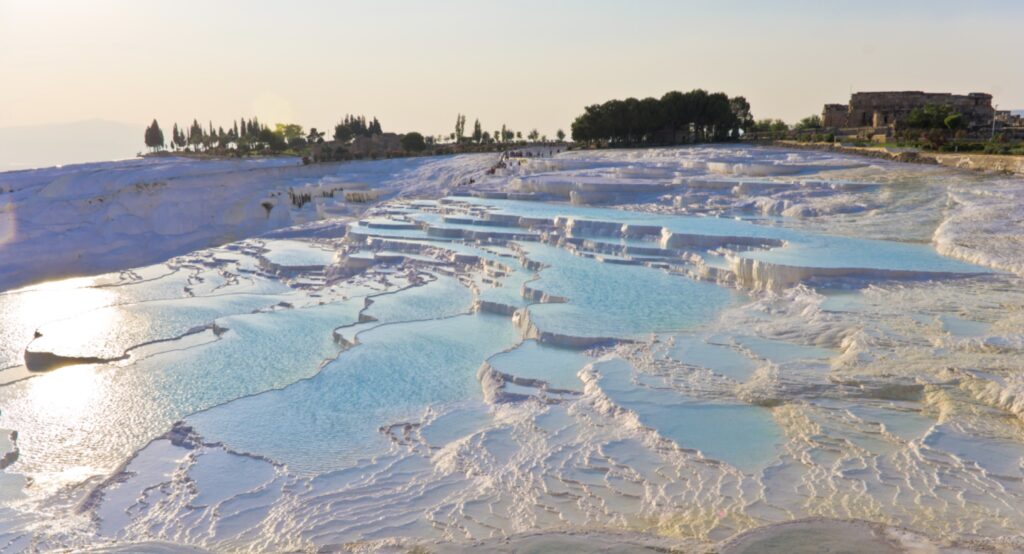
The landscape of Pamukkale is formed primarily through a geological process involving hot springs and the precipitation of minerals, particularly calcium carbonate. Here’s a detailed explanation of how it occurs:
- Thermal Springs: Pamukkale is situated in a tectonically active region with significant geothermal activity. Underground volcanic activity heats groundwater, causing it to become rich in dissolved minerals, especially calcium carbonate.
- Water Emergence: This mineral-rich hot water rises to the surface through fissures in the earth’s crust. As it flows over the landscape, it begins to cool.
- Precipitation of Minerals: As the water cools, the dissolved calcium carbonate precipitates out of the water, forming solid deposits. Over time, these deposits accumulate and create the terraces.
- Travertine Formation: The calcium carbonate forms a type of limestone called travertine. This process creates the white, terraced formations characteristic of Pamukkale. The terraces are constantly changing as new layers of travertine are deposited and old layers are eroded by the water flow.
- Pools and Stalactites: The terraces include natural pools and stalactites formed by the dripping and flow of mineral-laden water. The water flows from one terrace to another, creating a cascading effect.
- Continual Process: The formation of the terraces is an ongoing process. The landscape continually evolves as long as the thermal springs continue to supply mineral-rich water.
In essence, the unique and stunning landscape of Pamukkale is a result of the interplay between geothermal activity, mineral-rich hot springs, and the precipitation of calcium carbonate, creating a natural wonder that has been forming over thousands of years.
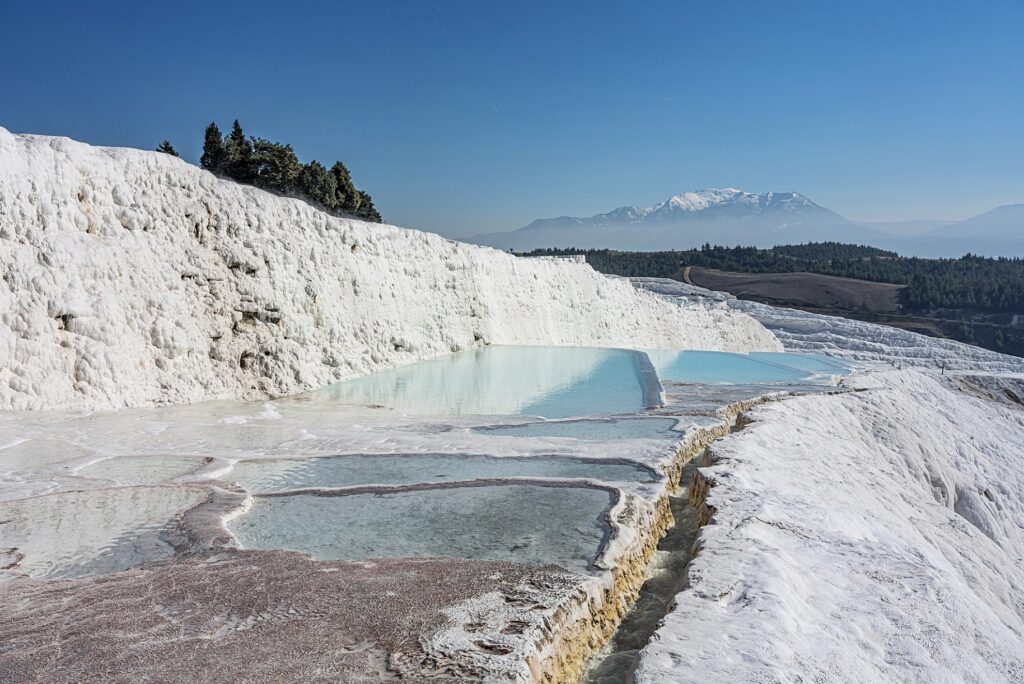
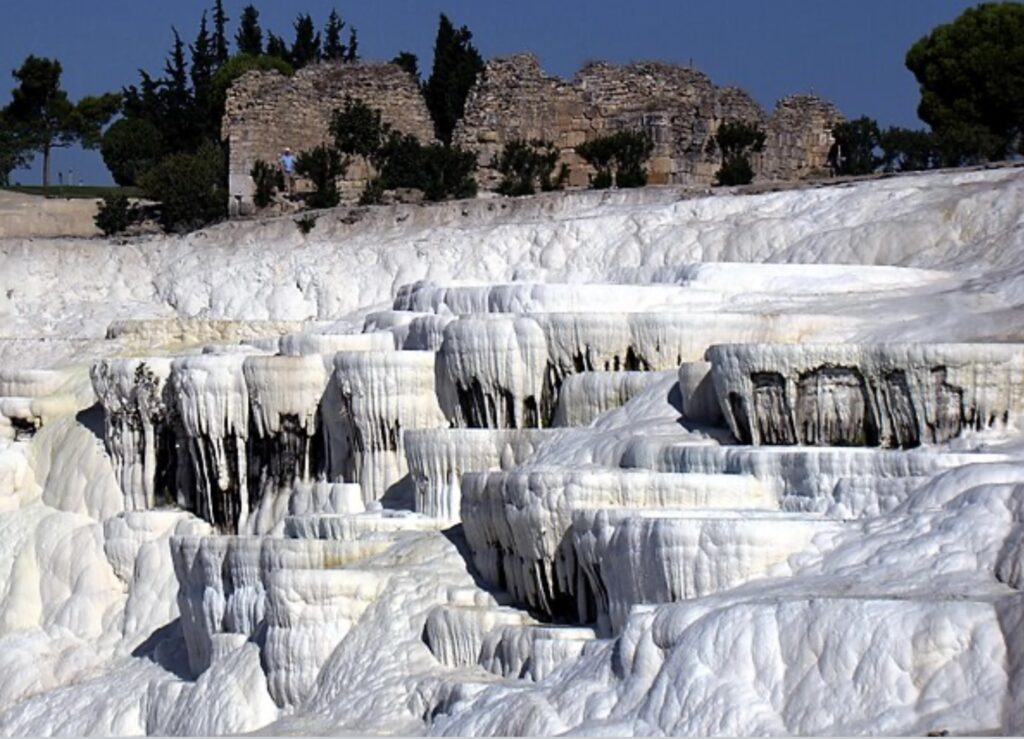
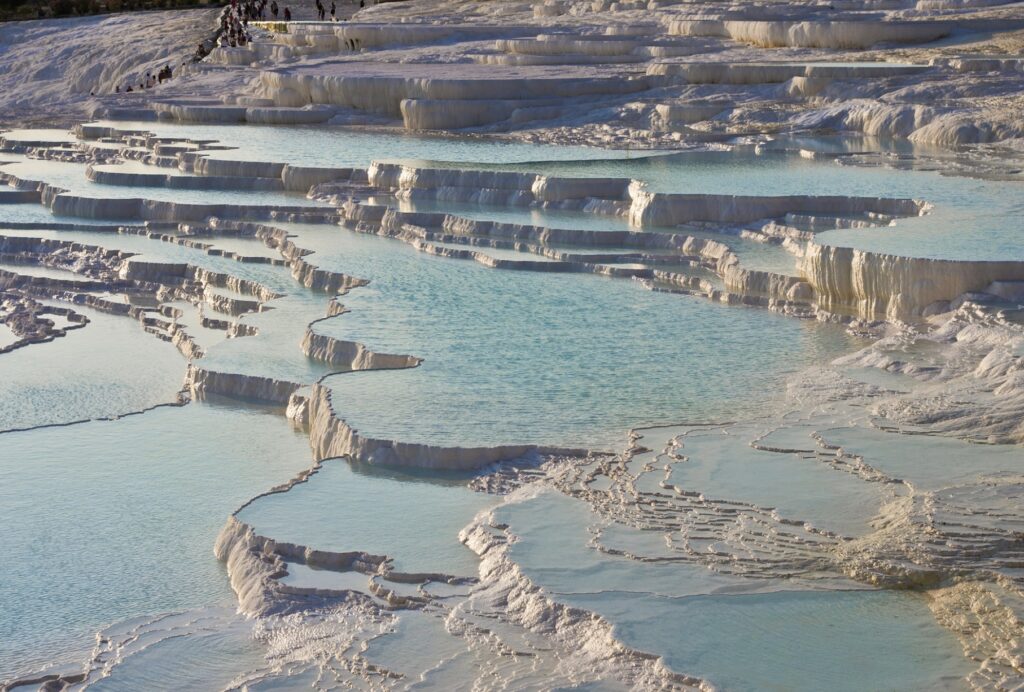
Hierapolis, an ancient city located near Pamukkale in southwestern Turkey, has a rich history that dates back to the 2nd century BCE. Here is an overview of its history and development:
Founding and Early History
- Hellenistic Period: Hierapolis was founded in the 2nd century BCE by the Attalid kings of Pergamon. The city’s name, derived from “Hiera” (sacred) and “polis” (city), reflects its religious significance. It was dedicated to Hiera, the wife of Telephus, a mythical founder of Pergamon.
- Roman Period: Hierapolis came under Roman control in 133 BCE when the last king of Pergamon bequeathed his kingdom to Rome. The city flourished during the Roman era, becoming an important center for trade, culture, and religion.
Development and Prosperity
- Thermal Springs: The city’s prosperity was closely tied to its thermal springs, which were believed to have healing properties. These springs attracted visitors from across the Roman Empire seeking cures for various ailments.
- Urban Development: Hierapolis was known for its impressive architecture, including a large theater, temples, baths, and a necropolis (cemetery). The city’s layout included wide streets, colonnaded avenues, and well-developed infrastructure.
Religious Significance
- Temple of Apollo: One of the most significant religious sites in Hierapolis was the Temple of Apollo, the city’s main deity. The temple was built over a sacred spring, emphasizing the city’s religious and therapeutic functions.
- Christianity: In the early Christian era, Hierapolis became an important center for the new religion. The Apostle Philip is believed to have been martyred here, and a martyrium (memorial) was built in his honor.
Decline and Modern Rediscovery
- Earthquakes: Hierapolis suffered from several devastating earthquakes, particularly in the 1st and 7th centuries CE. These natural disasters, along with changing political and economic conditions, led to the city’s decline.
- Abandonment: By the medieval period, Hierapolis was largely abandoned. However, its ruins remained an important historical and religious site.
- Rediscovery and Excavation: In the 19th and 20th centuries, archaeological excavations revealed the extent of Hierapolis’ ancient grandeur. The site’s well-preserved ruins and its proximity to Pamukkale have made it a major tourist attraction.
Modern Recognition
- UNESCO World Heritage Site: In 1988, Hierapolis, along with Pamukkale, was designated a UNESCO World Heritage Site, recognizing its historical, cultural, and natural significance. Visitors today can explore the ancient ruins, including the theater, temples, baths, and necropolis, as well as the striking travertine terraces of Pamukkale.
Hierapolis stands as a testament to the region’s historical and cultural richness, offering insights into ancient urban planning, religious practices, and the enduring appeal of its thermal springs.
Pamukkale
- Travertine Terraces: The stunning white terraces formed by calcium-rich thermal waters are the main attraction. Visitors can walk on designated paths and bathe in the thermal pools.
- Cleopatra’s Pool (Antique Pool): An ancient thermal pool where visitors can swim among submerged Roman columns, said to have been a gift from Marc Antony to Cleopatra.
- Natural Thermal Springs: The source of the mineral-rich waters that flow over the terraces, these springs are known for their therapeutic properties.
Hierapolis
- Hierapolis Theater: A well-preserved Roman theater with a seating capacity of around 15,000. It features elaborate stage buildings and is still used for performances today.
- Temple of Apollo: Dedicated to the city’s main deity, this temple was built over a sacred spring and is a significant religious site.
- Plutonium: A religious site dedicated to Pluto, the god of the underworld, known for its toxic gases that were believed to be the breath of Pluto.
- Nymphaeum: A monumental fountain that served as a public water source and a decorative feature in the city.
- Roman Baths: These large bath complexes were used for bathing, socializing, and medical treatments.
- Frontinus Street and Gate: The main street of Hierapolis, lined with columns and important buildings, leading to the impressive Frontinus Gate.
- Necropolis: One of the largest ancient cemeteries in Anatolia, with tombs and sarcophagi dating back to various periods.
- St. Philip’s Martyrium: A significant Christian site built to honor the Apostle Philip, who is believed to have been martyred in Hierapolis.
- Hierapolis Archaeological Museum: Located in the former Roman baths, this museum houses artifacts from Hierapolis and nearby archaeological sites.
Together, Pamukkale and Hierapolis offer a unique blend of natural beauty and historical significance, attracting visitors interested in both geology and ancient history.
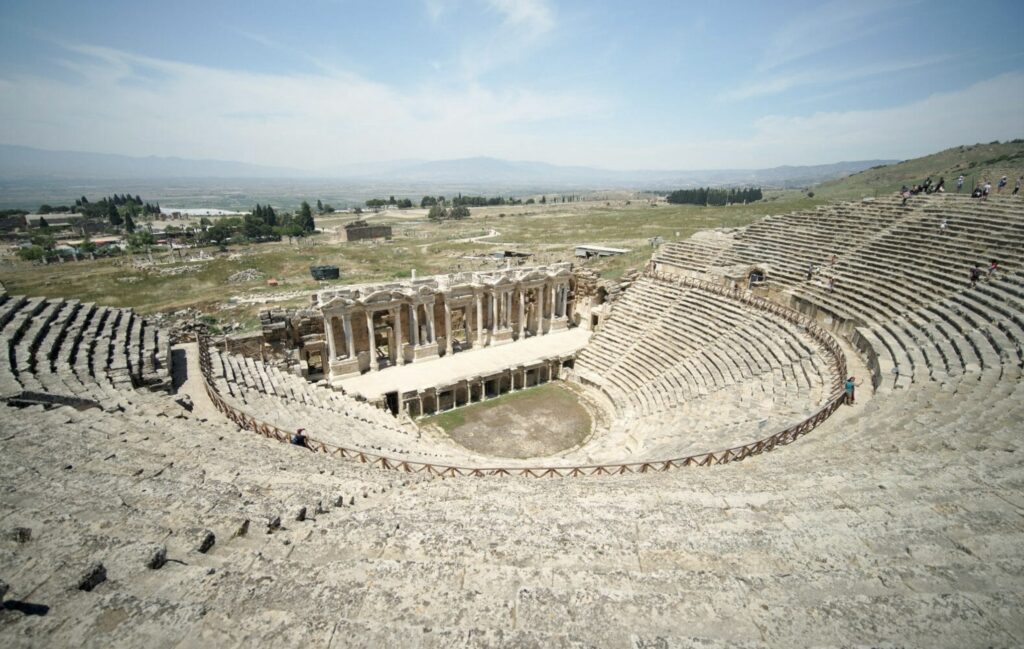
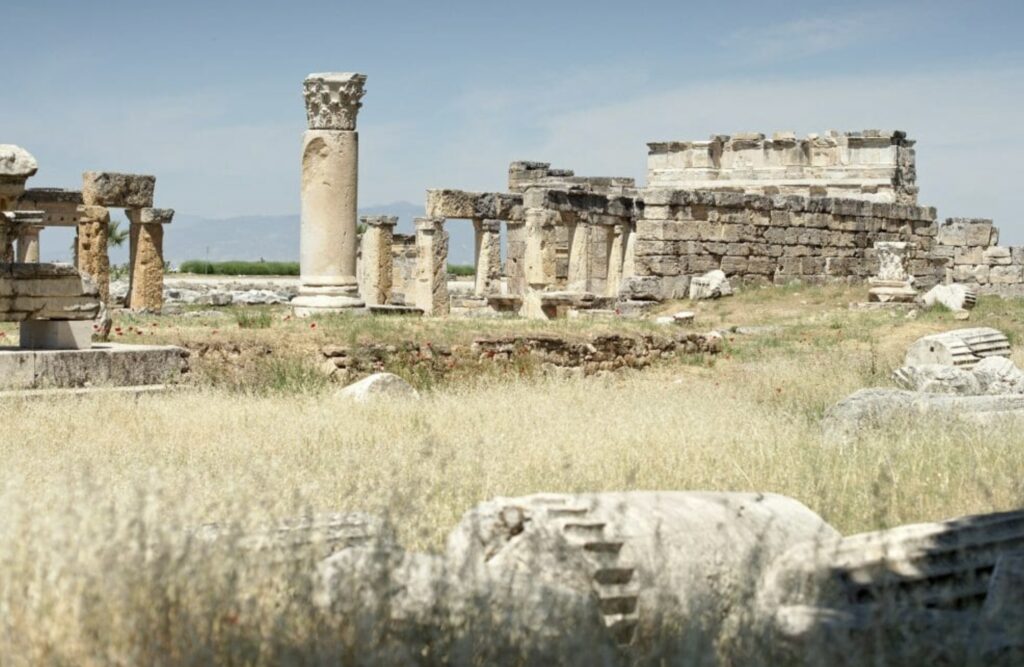
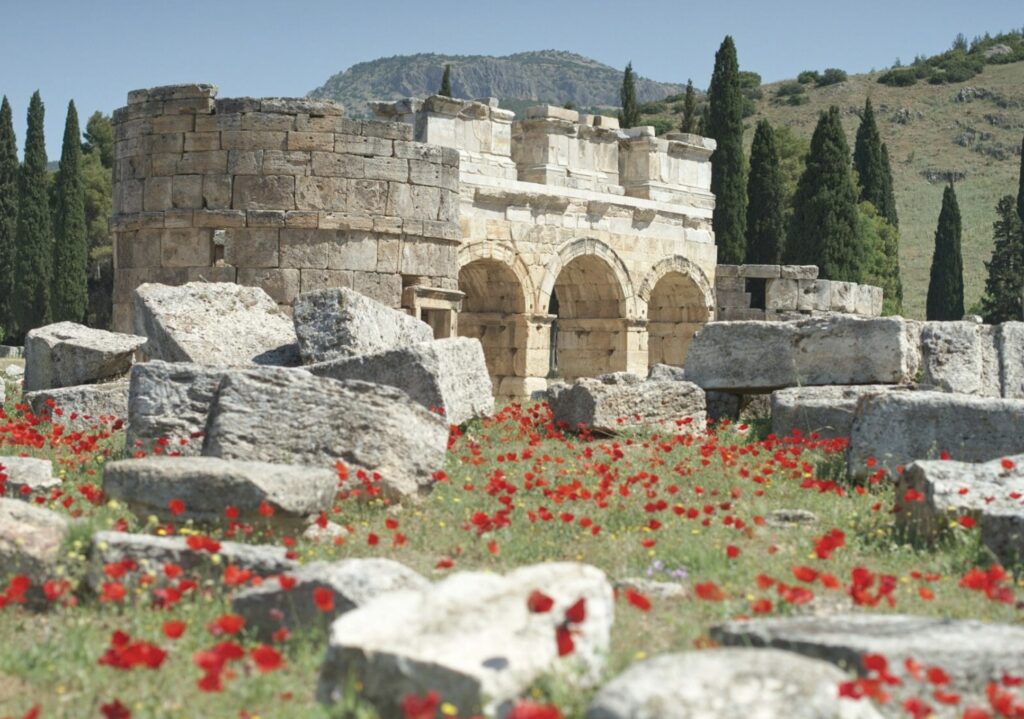
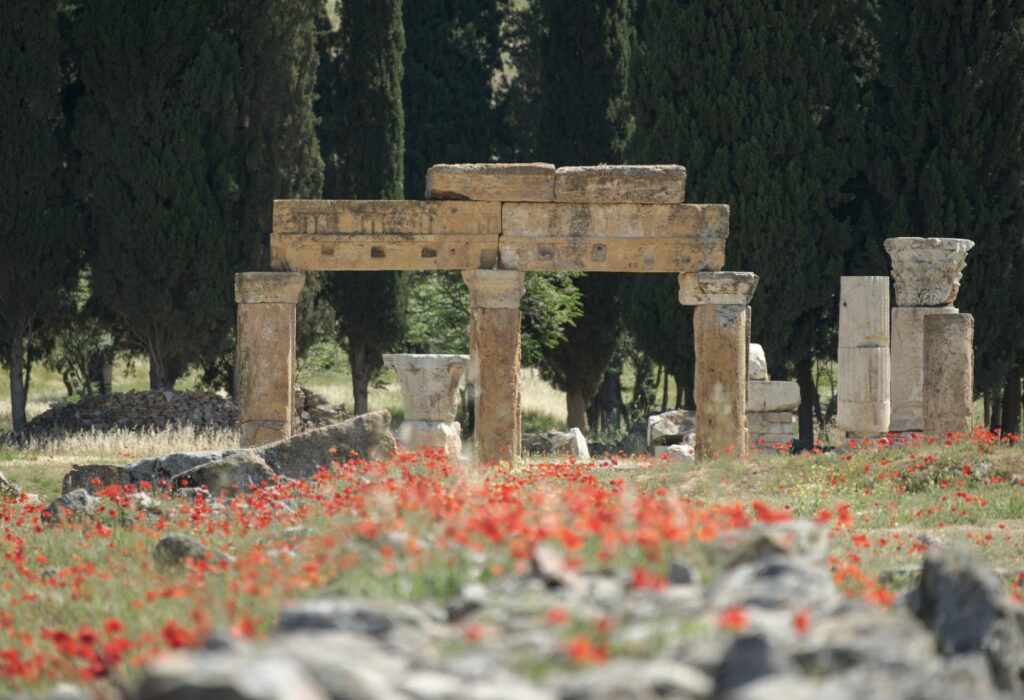
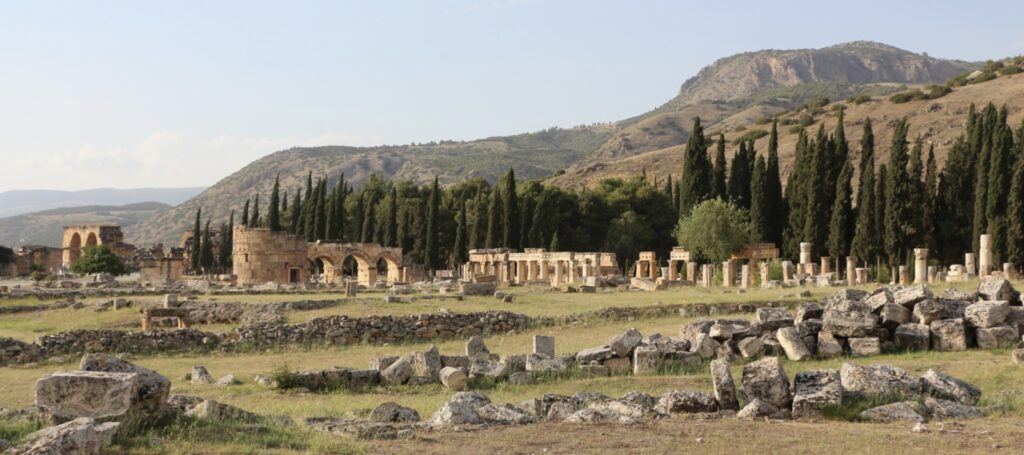
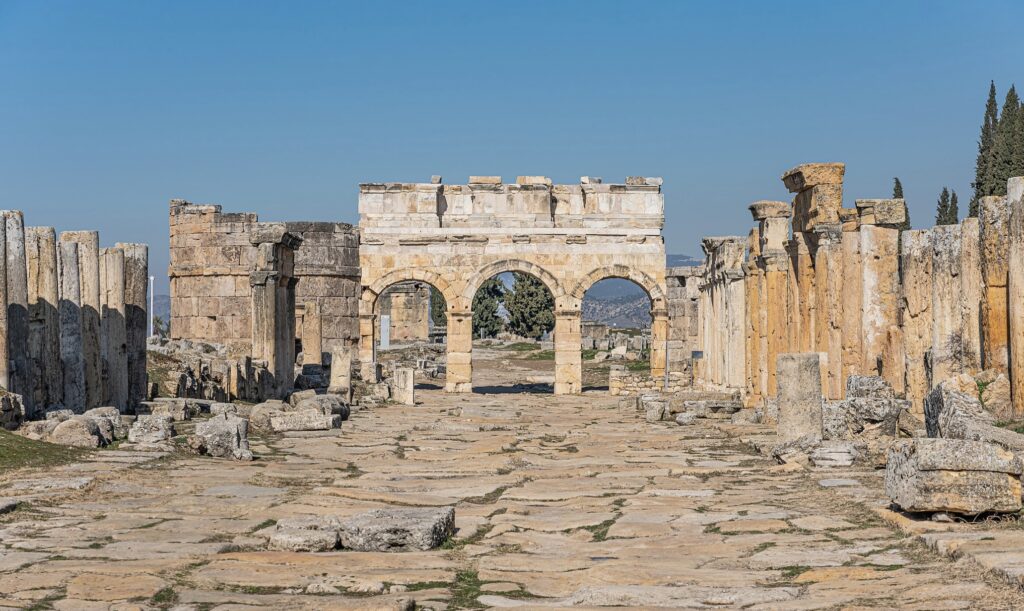
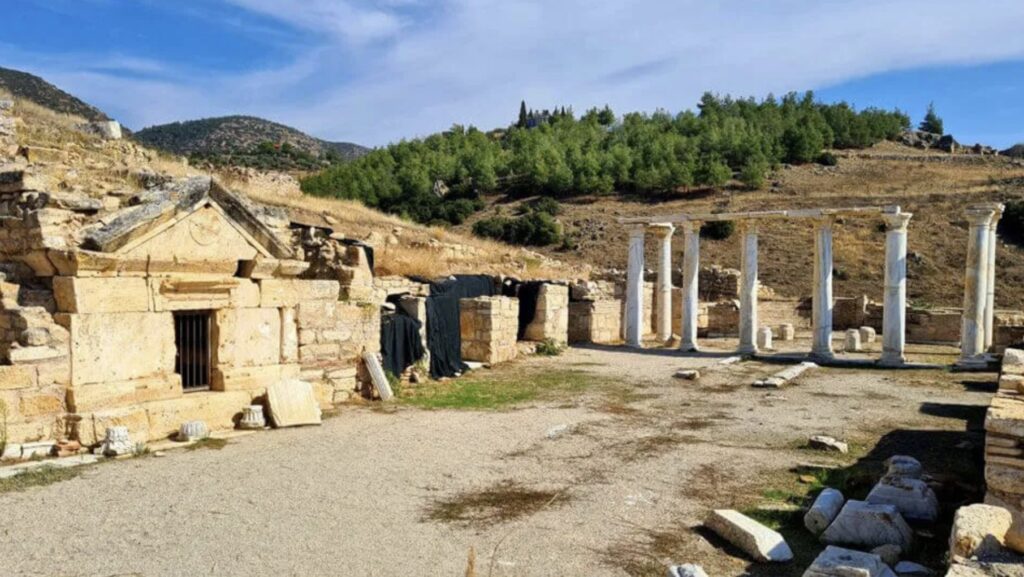
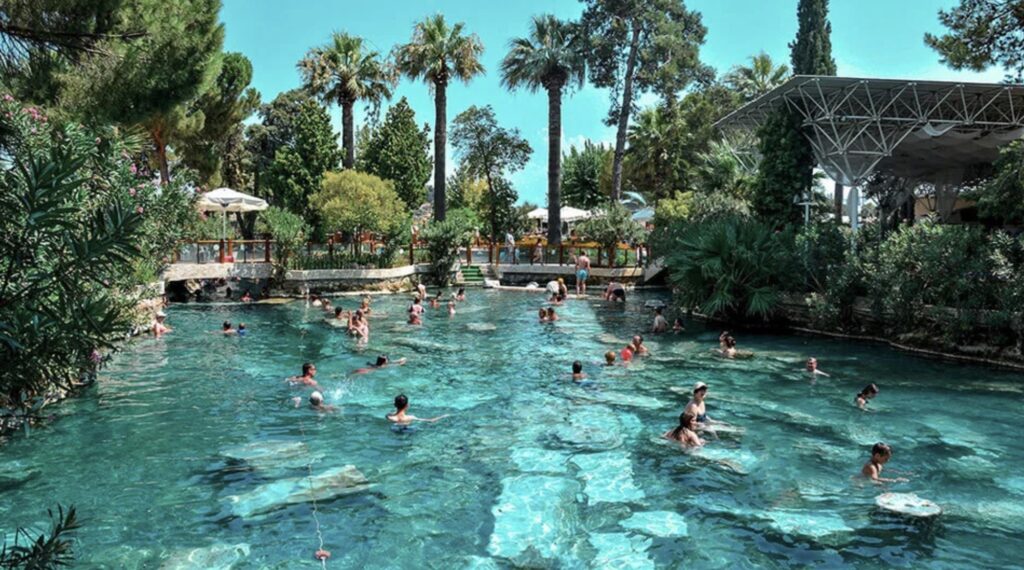
When visiting Pamukkale and the surrounding Denizli region, you can enjoy a variety of local Turkish specialties that reflect the rich culinary traditions of the area. Here are some notable dishes to try:
Local Food Specialties
- Denizli Kebab: A famous local dish, this kebab is made from marinated lamb or beef, grilled to perfection and typically served with flatbread, tomatoes, and onions.
- Kuzu Tandır: A slow-cooked lamb dish, tender and flavorful, often served with rice or bulgur.
- Çöp Şiş: Small skewers of marinated lamb or chicken, grilled and usually served with a side of salad or fresh bread.
- Kuru Fasulye: A hearty stew made from white beans, tomatoes, onions, and spices, often accompanied by rice or bread.
- Gözleme: A popular Turkish flatbread stuffed with various fillings such as cheese, spinach, potatoes, or minced meat, cooked on a griddle.
- Sarma: Grape leaves stuffed with a mixture of rice, pine nuts, currants, and spices, sometimes including minced meat.
- Pide: Often referred to as Turkish pizza, this dish consists of a flatbread topped with ingredients like cheese, meat, vegetables, and spices, then baked in a wood-fired oven.
- Börek: A pastry made of thin layers of dough filled with cheese, spinach, or minced meat, and baked until crispy.
- Manti: Turkish dumplings filled with spiced meat, served with a garlic yogurt sauce and drizzled with melted butter and paprika.
- Baklava: A sweet pastry made of layers of filo dough filled with chopped nuts and sweetened with syrup or honey, a must-try dessert.
- Sütlaç: A traditional Turkish rice pudding, often flavored with vanilla and cinnamon.
Beverages
- Çay: Turkish tea, typically served in small tulip-shaped glasses.
- Ayran: A refreshing yogurt-based drink, slightly salted.
- Turkish Coffee: Rich, strong coffee served in small cups, often enjoyed after meals.
These dishes offer a taste of the local flavors and culinary traditions.
Two-Day Itinerary for Visiting Pamukkale and Hierapolis
Day 1: Exploring Pamukkale
Morning
- Arrival and Check-In: Arrive in Pamukkale and check into your hotel. Many accommodations offer views of the terraces.
- Visit the Pamukkale Travertine Terraces: Start your day with a visit to the iconic white terraces. Walk barefoot on the designated paths and enjoy the unique landscape.
Late Morning
- Cleopatra’s Pool (Antique Pool): Head to Cleopatra’s Pool, where you can swim among submerged ancient columns. The water is warm and rich in minerals, perfect for a relaxing dip.
Lunch
- Local Cuisine: Have lunch at a nearby restaurant to taste traditional Turkish dishes. Many places offer outdoor seating with views of the terraces.
Afternoon
- Pamukkale Natural Park: Spend some time in the surrounding park area, where you can enjoy the gardens and scenic views.
Evening
- Sunset Over the Terraces: Return to the terraces to watch the sunset. The changing light creates stunning reflections and colors on the white travertine.
Dinner
- Dinner in Pamukkale Village: Enjoy a leisurely dinner in the village, sampling more local specialties.
Day 2: Exploring Hierapolis
Morning
- Hierapolis Ancient City: Start early to explore the ruins of Hierapolis. Begin with the Hierapolis Theater, one of the best-preserved Roman theaters in the region.
Late Morning
- Temple of Apollo and Plutonium: Visit the Temple of Apollo, followed by the Plutonium, an ancient religious site with historical significance.
Lunch
- Picnic Lunch: Pack a picnic lunch or find a nearby café. The archaeological site offers many spots to sit and enjoy a meal surrounded by history.
Afternoon
- Nymphaeum and Roman Baths: Continue your exploration with a visit to the Nymphaeum and the Roman Baths. These structures highlight the engineering and social aspects of ancient Roman life.
- Frontinus Street and Gate: Walk along Frontinus Street to see the main thoroughfare of Hierapolis, lined with columns and significant buildings, leading to the impressive Frontinus Gate.
Late Afternoon
- St. Philip’s Martyrium: Visit St. Philip’s Martyrium, a significant Christian site. The structure offers insight into early Christian architecture and history.
Evening
- Hierapolis Archaeological Museum: Conclude your visit with the Hierapolis Archaeological Museum, located in the former Roman baths. The museum houses artifacts from Hierapolis and nearby areas, providing a comprehensive overview of the region’s history.
Dinner
- Farewell Dinner: Enjoy a farewell dinner at a local restaurant, reflecting on the history and natural beauty you’ve experienced over the past two days.
This itinerary allows you to immerse yourself in the natural wonders of Pamukkale and the rich historical heritage of Hierapolis, making the most of your visit to these unique sites.
